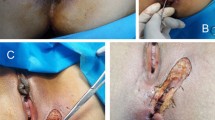Abstract
Introduction
Fistula-in-ano can be associated with a number of conditions, including Crohn’s disease. The majority, however, are classified as idiopathic or cryptoglandular. The aim of this study was to review the outcome of surgical management of fistula-in-ano in a specialist colorectal unit.
Materials and methods
One hundred and four consecutive patients underwent surgery for anal fistulae between 1st January 2000 and December 2004. Data was analysed in two main groups, according to the aetiology, cryptoglandular (n = 86) and Crohn’s disease (n = 18). Follow-up data was available on 91 patients.
Results
In the cryptoglandular group, 62 patients had an inter-sphincteric tract, of which 48 underwent a single-stage fistulotomy. Of those patients with a trans-sphincteric tract, six patients underwent a single-stage fistulotomy, 13 had a seton and staged fistulotomy. Follow-up data revealed that two fistulae recurred. The median number of procedures in this group was 1 (range 1–3). There was a significant difference in the inpatient stay depending of Park’s classification (p = 0.001). In the Crohn’s group, three patients with an inter-sphincteric tract underwent a single-stage fistulotomy, two patients with a trans-sphincteric tract had single-stage fistulotomy, and five required a loose seton and staged fistulotomy. Eight patients had multiple fistulae which required long-term setons. Four patients from this group eventually required proctectomy. In the Crohn’s group, there was a significantly increased complexity of surgery and higher recurrence. This was reflected in an increased inpatient length of stay and a greater reliance on imaging (p = 0.001). The median number of procedures in this group was 3 (range 1–5).
Discussion
The majority of cryptoglandular fistula-in-ano were treated by primary fistulotomy or staged fistulotomy with a loose seton. This was associated with a low recurrence rate and low rates of faecal incontinence. There was a low reliance on imaging techniques in this group. However, we would urge caution when dealing with fistula-in-ano related to Crohn’s disease. In this group of patients, the fistulae tended to be more complex and require additional imaging and multiple procedures.



Similar content being viewed by others
References
Parks AG, Gordon PH, Hardcastle JD (1976) A classification of fistula-in-ano. Br J Surgery 63:1–12
William JG, Mac Leod A, Rothenberger A, Goldberg M (1991) Seton treatment of high anal fistulae. Br J Surgery 78:1159–61
Miller GV, Finan PJ (1998) Flap advancement and core fistulectomy for complex rectal fistula. Br J Surgery 85:108–110
Van-de-stadt J (2000) Fistula-in-ano: the place of rectal advancement Flap technique. Acta Chir Belg 100:123–127
Jun SH, Choi GS (1999) Anocutaneous advancement flap closure of high anal fistulas. Br J Surgery 86:490–492
Parkash S, Lakshmiratan V, Gajendran V (1985) Fistula-in-ano: treatment by fistulectomy, primary closure and re-construction. Aust NZ J Surgery 55:23–27
Mann CV, Clifton MA (1985) Re-routing of the track for the treatment of high anal and anorectal fistulae. Br J Surgery 72:134–137
Park JJ, Cintron JR, Orsay CP, Pearl RK, Nelson RL, Sone JH et al (2000) Repair of chronic anorectal fistulae using commercial fibrin sealant. Arc Surg 135:166–169
Shoulder PJ, Crimely RP, Keighly MRB, Alexander WJ (1986) Fistula-in-ano is usually simple to treat surgically. Int J Colorectal Dis 1:113–115
Goodsall D, Miles W (1982) Classic articles in colonic and rectal surgery. Diseases of the anus and rectum. Dis Colon Rectum 25:262–278
Yang CY (1992) Fistulotomy and marsupialization for fistula-in-ano. Singapore Med J 33:268–270
Vainlevsky CA, Gordon PH (1985) Results of treatment of fistula-in-ano. Dis Colon Rectum 28:225–231
Ralto C, Gentile F, Merico M, Spinazzola C, Mangini G, Sofo L, Doglietto G (2000) How can the assessment of fistula-in-ano be improved. Dis Colon Rectum 43:1375–1382
Choen S, Burnett S, Bartram CI, Nicholls RJ (1991) Comparison between anal endosongraphy and digital examination in the evaluation of anal fistulae. Br J Surgery 78:445–447
Parks A, Stitz R (1976) The treatment of high fistula-in-ano. Dis Colon Rectum 19:487–499
Lunniss P, Thompson J (1994) The loose seton. In: Phillips RKS, Lunniss PJ (eds) Anal fistula. Surgical evaluation and management. Chapman & Hall, London, pp 87–94
Kuypers H (1984) The use of the seton in the treatment of extra-sphincteric anal fistula. Dis Colon Rectum 27:109–110
Belliveau P (2005) Anal fistula. In: Fazio VW, Church JM, Delaney CP (eds) Current therapy in colon and rectal surgery. Mosby, St. Louis, MO, USA, pp 27–34
Buchanan G, Owen H, Torkington J, Lunniss P, Nicholls RJ, Cohen CR (2004) Long-term outcome following loose-seton technique for external sphincter preservation in complex anal fistula. Br J Surgery 91:476–80
Hammond T, Grahn M, Lunniss P (2005) Fibrin glue in the management of anal fistulae. Colorectal Dis 8:308–319
Lindsey I, Smilgin-Humphreys M, Cunningham C, Mortensen N, George B (2002) A randomized controlled trial of fibrin glue vs. conventional treatment for anal fistula. Dis Colon Rectum 45:1608–1615
Talbot C, Sagar P, Johnston M, Finan P, Burke D (2005) Infliximab in the surgical management of complex fistulating anal Crohn’s disease. Colorectal Dis 7:164–168
Gaertner W, Decanini A, Mellgren A, Lowry A, Goldberg S, Madoff R, Spencer M (2007) Does infliximab infusion impact results of operative treatment for Crohn’s perianal fistulas? Dis Colon Rectum 50:1754–1760
Author information
Authors and Affiliations
Corresponding author
Rights and permissions
About this article
Cite this article
Davies, M., Harris, D., Lohana, P. et al. The surgical management of fistula-in-ano in a specialist colorectal unit. Int J Colorectal Dis 23, 833–838 (2008). https://doi.org/10.1007/s00384-008-0444-x
Accepted:
Published:
Issue Date:
DOI: https://doi.org/10.1007/s00384-008-0444-x




